2012-2016
Toyota Camry Front Brake Pads Replacement Guide
How to replace the front brake pads on an
XV50 7th generation 2012-2016 Toyota Camry with picture illustrated steps.
By Paul B. Michaels Author & Photographer Auto Mechanic Since 1989 |
||
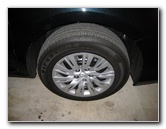 2013 Camry Front Wheel |
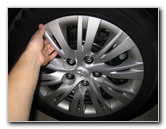 Pull Off Wheel Cover |
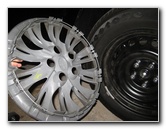 Hub Cap Removed |
| This
automotive "how-to" guide was specifically written to assist owners
of the XV50 7th generation (2012, 2013, 2014, 2015 & 2016)
Toyota Camry in changing the front brake pads. Owners of other Toyota, Scion or Lexus vehicles such as the Yaris, Corolla, Matrix, RAV4, Prius, Tacoma, Tundra, Sienna, FJ Cruiser, Venza, Highlander, Avalon, 4Runner, Land Runner, Sequoia, IS 250, ES 350, GS 350, tC, xB, xD, iQ and FR-S may also find these DIY brake job instructions to be helpful. The tools required to complete this procedure include a floor jack, jack stands, a lug nut wrench, a 14mm socket, a thin 17mm cone spanner wrench, a "C" or "F" clamp, and a packet of brake parts lubricant or "brake caliper grease". A few compatible replacement brake pads with their part numbers are as follows: Wagner ThermoQuiet QC1293, Raybestos PGD1222C or ATD1222C, Akebono ASP1222, ProAct ACT1222, Bosch BP1293, Centric 105.1293 and ACDelco 17D1222CH. |
||
|
|
||
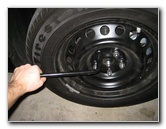 Slightly Loosen Lug Nuts |
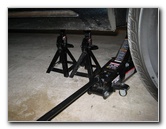 Raise Front of Vehicle |
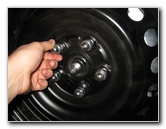 Spin Off 5 Lug Nuts |
| The first step is
to park the vehicle on a level surface. Then engage the emergency/parking
brake and chock the rear wheels to prevent the car from rolling backwards. Slightly loosen the five lug nuts on the front wheel with the tire iron by turning them counter clockwise. Raise the front of the vehicle with the floor jack and securely support it with at least two jack stands. (I prefer to work on one side of the car at a time for extra safety.) |
||
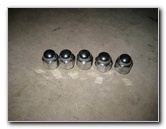 5 Lug Nuts Removed |
 Caliper, Rotor, Bracket |
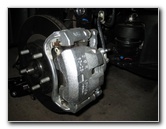 Front Brake Caliper |
| Spin off the 5 lug
nuts and set them aside in a safe place. Pull off the front wheel to reveal
the brake caliper, bracket and rotor. The front brake caliper is held on to the bracket by two bolts located on the back side of the caliper. |
||
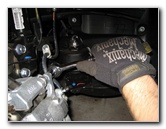 Loosen 14mm Caliper Bolt |
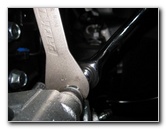 Hold Pin With 17mm Wrench |
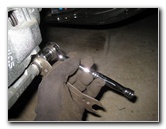 Loosen Lower Caliper Bolt |
| Loosen the upper
caliper bolt with the 14mm socket and ratcheting wrench.
If the caliper slider pin turns as you are trying to loosen the caliper bolt, hold it in place with a thin 17mm cone spanner wrench. Loosen the lower caliper bolt with the 14mm socket, ratcheting wrench and 17mm cone spanner wrench. |
||
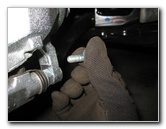 Remove Lower 14mm Bolt |
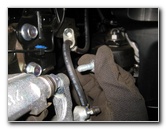 Remove Upper Caliper Bolt |
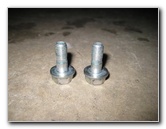 Set Aside Two Caliper Bolts |
| Remove the two caliper bolts and set them aside in a safe place. | ||
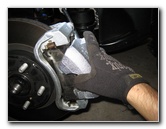 Lift Off Brake Caliper |
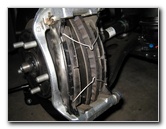 Old Pads Exposed |
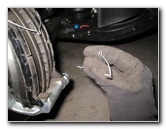 Remove "V" Springs |
| Carefully lift the
brake caliper off the old pads and out of the bracket. Rest the caliper on top of the suspension or suspend it with a bungee cord. The front brakes are equipped with two metal "V" springs that help keep the pads off the rotor when not braking. |
||
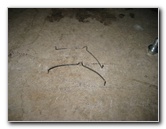 Two "V" Springs Removed |
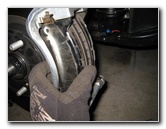 Remove Outer Pad |
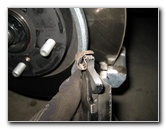 Wear Bar At Top |
| Remove the two "V"
springs and set them aside in a safe place. Pull the old brake pads out of the bracket and make a note of how the "squeal" or wear bars are situated. On this 2013 Camry, there are wear bars located at the top of both the inner and outer brake pads. I would recommend buying the Wagner ThermoQuiet QC1293 pads. I've always had great experiences with them. I also like how they don't require any shims, backing plates or disc brake quiet gel due to the integrated insulators. |
||
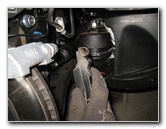 Wear Bar On Inner Pad |
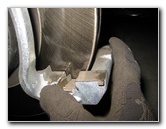 Replace Pad Abutment Clips |
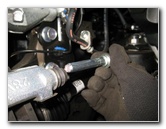 Pull Out Upper Caliper Pin |
| If your new front
brake pads came with new metal pad abutment or "anti-rattle" clips, pull the
old ones out of the top and bottom of the bracket before installing the new
ones. In order for the brake caliper to operate smoothly, the upper and lower caliper slider pins need to be well lubricated. Carefully pull the upper and lower caliper pins out of their rubber dust boots and apply a thin layer of brake parts lubricant to each before pushing them back in. Try to avoid damaging the rubber dust boots. |
||
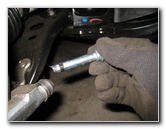 Lower Caliper Slider Pin |
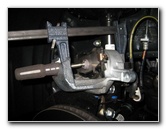 Attach "C" Clamp To Piston |
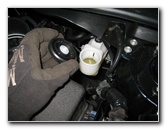 Twist Off Brake Fluid Cap |
| In order for the
caliper to fit over the thicker new brake pads, the caliper piston needs
to be compressed backwards.
Attach the "C" or "F" clamp to the caliper using the back of an old brake pad to evenly distribute the pressure. Move to the right rear side of the engine bay (near the driver) and twist off the brake fluid reservoir cap in the counter clockwise direction. Removing the brake fluid reservoir cap will allow the fluid to more easily travel back through the lines when you compress the caliper piston. |
||
|
|
||
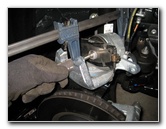 Compress Caliper Piston |
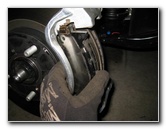 Install New Outer Pad |
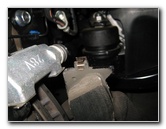 Wear Bars At Top of Pads |
| Slowly compress the
caliper piston until it is flush with the rubber dust boot.
Repeatedly check the brake fluid level in the reservoir while you compress the caliper piston to make sure that it does not over flow. Clean up any spilled brake fluid immediately since it can quickly damage painted surfaces. Replace the brake fluid reservoir cap as soon as possible since brake fluid is hygroscopic (readily absorbs moisture). Thoroughly clean off the brake rotor, caliper bracket, brake caliper assembly and the lug nut studs with brake parts cleaner spray. Do not use compressed air or blow with your mouth to clean off the brake parts since breathing in brake dust can be harmful to your health. Brake dust can be carcinogenic (causes cancer) if inhaled.
To remove the existing rotors and install new ones, remove the two 17mm bolts on the rear of the caliper bracket that attach it to the steering knuckle. Then loosen the old rotor with a rubber mallet, pull it off, and slide the new one in its place. |
||
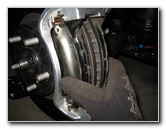 Push Pads Against Rotor |
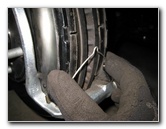 Re-Install Metal "V" Springs |
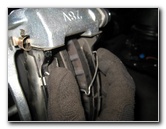 Upper "V" Spring Installed |
| Apply a thin layer
of brake caliper grease to any area where there is metal to metal contact
such as on the lip of the caliper piston. Do not apply brake parts lubricant
to the friction surface of the new pads. Install the new outer and inner brake pads in to the bracket with the wear bars situated at the top of each one. Push the two new brake pads flush against the rotor. Re-install the two metal "V" springs with the narrow ends facing each other. Continue holding the pads against the rotor while you line up the caliper. |
||
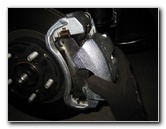 Lower Caliper Over Pads |
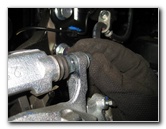 Thread In Upper Caliper Bolt |
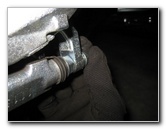 Replace Lower Caliper Bolt |
| Carefully lower the caliper over the new
brake pads and in to the bracket. If the caliper won't fit over the new
pads, you may need to compress the piston back a bit further. Line up the bolt holes in the caliper with the corresponding holes in the caliper slider pins. Re-insert the two caliper bolts by hand to prevent them from becoming cross threaded. |
||
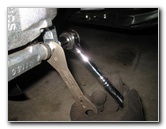 Tighten Lower Caliper Bolt |
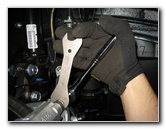 Tighten Upper 14mm Bolt |
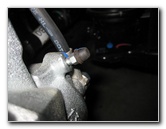 Rubber Valve Cap |
| Tighten the two
caliper bolts by turning them counter clockwise (as seen from the outside of
the vehicle) with the 14mm socket, ratcheting wrench and 17mm cone spanner
wrench to just past hand tight or about 25 ft lbs of torque. Double check that the two caliper bolts are tight before continuing on to the next steps. If your brake pedal previously felt soft or spongy, the brake fluid may be contaminated with water or the brake lines may contain some air bubbles. It would be best to bleed the brake lines at this time in order to flush out the old fluid and replace it with fresh DOT3 brake fluid. For more on this topic, check out my Brake Line Fluid Bleeding With An Assistant DIY Guide or alternatively the Brake Line Fluid Bleeding With A Power Bleeder Guide. The brake fluid bleeder valve is located underneath a rubber cap on the back side of the caliper just below the upper caliper bolt. |
||
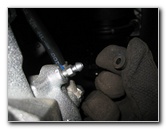 Brake Fluid Bleeder Valve |
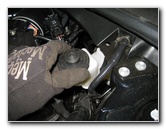 Replace Brake Fluid Cap |
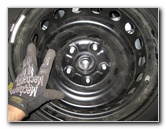 Replace Front Wheel |
| If you haven't
already, replace the brake fluid reservoir cap. Replace the front wheel and spin on the five lug nuts by hand to prevent them from becoming cross threaded. |
||
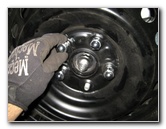 Spin On 5 Lug Nuts |
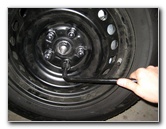 Slightly Tighten Lug Nuts |
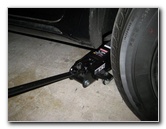 Lower Vehicle With Jack |
| Slightly tighten
the 5 lug nuts in a "criss cross" or "star" pattern with the lug nut wrench. Lower the vehicle from the jack stands using the floor jack. |
||
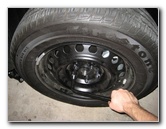 Torque Lug Nuts |
 Push On Wheel Cover |
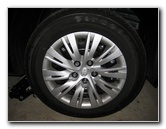 Front Brake Pads Replaced |
|
Continue tightening the lug nuts in a criss
cross or star pattern to about 1/4 to 1/3 turn past hand tight or about 76
ft lbs of torque. It would be best to use a torque wrench or an impact
wrench with a torque stick to properly tighten the lug nuts. Sit in the driver's seat of the vehicle and pump the brake pedal a few times to restore the brake line pressure. Check the brake fluid in the reservoir and verify that it is at the proper level. If it is low, add some DOT 3 fluid. To break in your new front brake pads, just drive normally for the first few hundred miles while trying to avoid any hard or "panic" stops which may glaze over the new pads and cause them to be noisy and/or not perform as well. It's also a good idea to regularly check your driveway for drops of brake fluid which may indicate a leak, check the brake fluid level in the reservoir, and also verify that the lug nuts are still tight. For more,
check out my other
2012-2016 Toyota Camry DIY Repair & Maintenance Guides. |
||
| If you found this guide to be helpful,
please consider making a small donation by clicking on the PayPal.com
"Donate" button located to the right of this paragraph. Thank you!
(Note: I am not a registered charity. Donations are not tax deductible.) |

